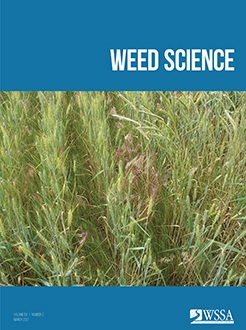Barnyardgrass [Echinochloa crus-galli (L.) P. Beauv.] is a problematic weed in rice (Oryza sativa L.) fields. Overapplication of herbicides causes environmental pollution and the emergence of resistant weeds, and integrated weed management methods can reduce dependence on herbicides. The growth of E. crus-galli and rice seedlings was shown to be significantly inhibited by high concentrations of fulvic acid (FA, C14H12O8) under flooding conditions (HF, 0.80 g L–1) (P < 0.05). In contrast, seedling growth was promoted by the application of very low concentrations of FA (LF, 0.02 g L–1). The activities of glutathione S-transferase (GST) and antioxidant enzymes, including total superoxide dismutase (T-SOD), peroxidase (POD), and catalase (CAT), in E. crus-galli seedlings were enhanced by the LF treatment; while POD activity decreased and GST, T-SOD, and CAT activity was not significantly altered by the HF treatment. The metabolomic and transcriptomic analyses showed that FA regulated E. crus-galli seedling growth by affecting the synthesis of indole derivatives and flavonoid compounds. Compared with the blank control (CK, 0 g L–1), the levels of four indole derivatives were upregulated under the HF treatment, and the indole derivatives were slightly downregulated under the LF treatment. The flavonoids, including naringenin, naringenin chalcone, eriodictyol, kaempferol, and epigallocatechin, were downregulated under HF treatment, and the growth of E. crus-galli was reduced. In contrast, the metabolism and transcription of flavonoids were not significantly altered by the LF treatment. The addition of 0.80 g L–1 FA obviously inhibited the growth of newly sprouted E. crus-galli, whereas rice growth was significantly promoted 8 d after rice planting (P < 0.05). The application of FA, therefore, might be a potential integrated weed management method to control the damage caused by E. crus-galli in paddy fields.
How to translate text using browser tools
5 January 2021
Effect of Fulvic Acid on Barnyardgrass (Echinochloa crus-galli) Seedling Growth under Flooding Conditions
Shangfeng Zhou,
Yi Tang,
Lang Pan,
Cong Wang,
Yanan Guo,
Haona Yang,
Zuren Li,
Lianyang Bai,
Lifeng Wang
ACCESS THE FULL ARTICLE

Weed Science
Vol. 69 • No. 2
March 2021
Vol. 69 • No. 2
March 2021
growth inhibition
metabolomic
rice
transcriptomic
weed control




